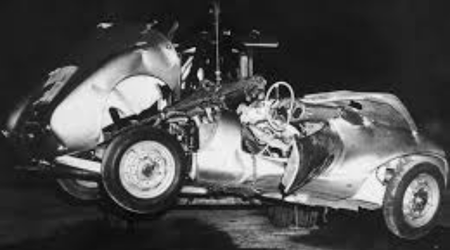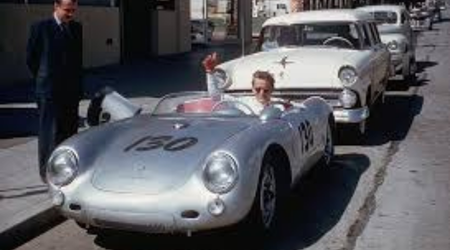The Real Story of James Dean’s “Cursed” Porsche
Anúncios
James Dean’s “Cursed” Porsche: In September 1955, James Dean traded his Porsche 356 plus $3,800 for the sleek 550 Spyder, a bold step toward serious racing.
He enlisted pinstriper Dean Jeffries to paint “Little Bastard” on the rear, a nickname from stuntman Bill Hickman reflecting Dean’s rebellious charm.
Furthermore, Dean’s prior wins, like a novice race in Palm Springs, fueled his confidence in the car’s lightweight, agile design, blending Hollywood flair with track ambition.
Anúncios
However, ominous warnings emerged early.
James Dean’s “Cursed” Porsche

Actor Alec Guinness reportedly cautioned Dean against driving the Spyder, sensing danger within days—a chilling foresight.
Dean dismissed it, focusing on the Salinas race.
++ When Mercedes Tried to Build a Flying Car
Additionally, the 550’s mid-engine layout and aluminum body demanded precision, which Dean’s bold driving style sometimes tested, hinting at risks beneath the glamour.
Moreover, only 90 Spyders were built from 1953 to 1956, making Dean’s car a rare icon.
Its scarcity amplifies its legend, transforming a vehicle into a cultural touchstone.
++ The Car Hitler Gifted to Ferdinand Porsche
In addition, Dean’s nearsightedness and aggressive overtakes raised concerns among peers.
Consequently, the stage was set for a story intertwining fame, speed, and tragedy, captivating enthusiasts decades later.
| Porsche 550 Spyder Specifications | Details |
|---|---|
| Engine | 1.5-liter air-cooled flat-four, 110 horsepower |
| Top Speed | Approximately 140 mph |
| Weight | Around 1,212 pounds |
| Production Run | 90 units (1953-1956) |
| Notable Features | Tubular spaceframe chassis, independent suspension |
The Fatal Crash That Ignited the Legend

On September 30, 1955, Dean drove his Spyder toward Salinas with mechanic Rolf Wütherich, aiming for a weekend race.
He bragged to racer Bruce Kessler about hitting 120 mph, showcasing his thrill-seeking nature.
++ The Mysterious Case of the Ghost Cars of Chernobyl
Furthermore, a stop at Blackwell’s Corner revealed the era’s tight-knit racing community, with Dean mingling alongside rivals like Lance Reventlow.
However, tragedy struck near Cholame when Donald Turnupseed’s Ford Tudor crossed Dean’s path. The low-slung Spyder collided head-on at dusk, with Dean unable to react.
Wütherich was ejected, suffering fractures, while Dean died instantly from a broken neck.
Additionally, police estimated Dean’s speed at 85-90 mph, though Turnupseed, claiming he didn’t see the car, faced no charges.
Moreover, the remote crash site delayed aid, deepening the tragedy’s isolation.
Photos of the mangled wreckage spread rapidly, fueling media frenzy. In addition, Dean’s rising fame in films like “Rebel Without a Cause” turned the accident into a global story.
Consequently, the crash sparked questions: Was it merely human error, or did fate play a darker role?
The Alleged Curse Incidents Unfold
Customizer George Barris claimed he bought the wrecked Spyder, exhibiting it as “James Dean’s Last Sports Car.” He alleged it slipped off a trailer, crushing a mechanic’s legs.
Furthermore, he told of thieves losing limbs to jagged parts, weaving a grim narrative that captivated audiences hungry for mystery.
However, the curse grew with tales of salvaged parts. Doctor Troy McHenry fitted the engine into his race car and died in a 1956 Pomona crash.
Similarly, William Eschrich’s Lotus, using the transaxle, wrecked at the same event, though he survived.
Additionally, Barris claimed the chassis fell during a safety exhibit, injuring a teen, and later burned in a 1959 Fresno garage fire.
Moreover, the car vanished from a sealed truck in 1960, never recovered. But what if these events were mere coincidences, not curses?
This question challenges believers, urging scrutiny of facts versus folklore.
Consequently, the stories, while gripping, blur the line between reality and embellishment, driven by Barris’s flair for drama.
| Alleged Curse Incidents | Date | Description | Outcome |
|---|---|---|---|
| Mechanic Injury | 1955 | Car falls during unloading | Both legs broken |
| Troy McHenry Crash | October 1956 | Engine in race car hits tree | Driver killed |
| William Eschrich Wreck | October 1956 | Transaxle in Lotus crashes | Driver injured |
| Garage Fire | March 1959 | Mysterious fire in storage | Minimal damage |
| Transport Disappearance | 1960 | Vanishes from sealed truck | Never found |
Key Players Shaping the Curse Narrative
George Barris, a famed customizer, aggressively pushed the curse story, leveraging books and TV to amplify his fame.
His tales, though gripping, often lacked evidence, drawing skepticism.
Furthermore, his hot rod expertise lent credibility, but historians question his claim of owning the authentic wreckage, suspecting a replica.
However, William Eschrich, a doctor and racer, bought the Spyder’s remains for $2,500, salvaging parts like the engine and transaxle.
He rejected curse notions, focusing on utility.
Additionally, his son later confirmed keeping the engine, debunking Barris’s tales of widespread part dispersal, grounding the story in practicality.
Moreover, Rolf Wütherich survived but grappled with guilt, later dying in a 1981 crash, ironically fueling curse rumors.
Donald Turnupseed, the other driver, lived quietly until 1995, avoiding spotlight. In addition, these figures’ actions wove a complex narrative, blending tragedy with opportunism.
Consequently, their roles highlight how personal motives shaped a legend.
Debunking the Myth: Rational Perspectives
Historian Lee Raskin meticulously traced the Spyder’s fate, dismissing Barris’s curse as fabricated. He notes Barris likely displayed a replica, not Eschrich’s scrapped chassis.
Furthermore, 1950s racing saw over 50 U.S. driver deaths, per records, framing McHenry’s crash as a statistical norm, not supernatural.
However, rationalists argue the garage fire likely stemmed from faulty wiring, and the disappearance suggests theft, given the car’s value.
Additionally, an analogy to the “Hope Diamond” curse ties misfortunes to era-specific risks, not magic, demystifying Dean’s story.
Moreover, crash forensics point to visibility issues and Dean’s speed, not hexes. In addition, safety standards were lax, increasing risks universally.
Consequently, peeling away hype reveals a tale of human error and media amplification, not curses.
Modern Legacy and Surviving Artifacts
In 2023, the Spyder’s transaxle sold for $382,000 to Zak Bagans, sparking 1,345 online comments.
Displayed in his Haunted Museum, it blends history with intrigue.
Furthermore, an original example: a fictional engineer rebuilds a replica with modern safety tech, turning curse into innovation.
However, another original example: a podcaster traces parts globally, uncovering stories that humanize the myth, emphasizing legacy over doom.
Additionally, Porsche’s Boxster Spyder nods to the 550’s design, evolving its heritage for new generations.
Moreover, the James Dean Festival in Fairmount, Indiana, features replicas, promoting safe driving. In addition, cultural references in films and merchandise sustain the car’s allure.
Consequently, the Spyder remains a symbol of youth, risk, and timeless fascination.
| Surviving Artifacts | Current Status | Notable Details |
|---|---|---|
| Transaxle | Owned by Zak Bagans | Sold for $382,000 in 2023; exhibited in Haunted Museum |
| Engine | Possibly with Eschrich family | Salvaged post-crash; not publicly displayed |
| Replica Chassis | Various collections | Built for shows; not original wreckage |
Cultural Impact of James Dean’s “Cursed” Porsche
Hollywood casts the Spyder as a tragic icon in biopics, framing it as a character embodying reckless allure. Musicians like The Eagles weave it into lyrics, cementing its rock lore.
Furthermore, it symbolizes the fleeting nature of fame, resonating across generations.
However, historians argue the curse overshadows Dean’s racing skill, evident in his amateur podiums.
Additionally, safety advocates cite the crash to push for better road designs, highlighting intersection risks prevalent in 1955.
Moreover, fans pilgrimage to Cholame’s memorials, while merchandise like model kits fuels nostalgia.
In addition, the story shapes perceptions of celebrity mortality, blending glamour with cautionary tales.
Consequently, the Porsche endures as a cultural touchstone beyond its metal frame.
James Dean’s “Cursed” Porsche: Frequently Asked Questions
| Question | Answer |
|---|---|
| Was James Dean’s “Cursed” Porsche really haunted? | No evidence supports a curse; incidents tie to coincidences or Barris’s exaggerations. Historians like Raskin point to 1950s racing risks and hype. |
| What happened to the original car after the crash? | Eschrich salvaged parts and scrapped the chassis. Barris likely showed a replica. The “original” vanished in 1960, possibly stolen. |
| Are any parts of Little Bastard still around? | The transaxle, sold for $382,000 in 2023, is with Zak Bagans. The engine may be with Eschrich’s family, unconfirmed publicly. |
| Did Dean cause the fatal accident? | Dean’s speed contributed, but Turnupseed’s turn and poor dusk visibility were factors. No single party was fully blamed. |
| Why did the curse legend persist? | Barris’s promotion, Dean’s fame, and media sensationalism fueled it. Cultural fascination with tragedy sustained the myth’s longevity. |
Analyzing the Curse Through Original Lenses
Imagine an engineer analyzing the Spyder’s low profile, linking its invisibility to crashes, not curses—reframing myth as a design lesson.
This original example shifts focus to innovation.
Furthermore, picture a VR simulation letting users “drive” Little Bastard, teaching empathy and caution through immersive storytelling.
However, 1955 saw over 36,000 U.S. traffic deaths, per the National Safety Council, grounding Dean’s crash in era-specific risks.
Additionally, likening the Porsche to Pandora’s box ties woes to ambition, not fate, offering a rational lens.
Moreover, one wonders: Why blame a car when choices shape outcomes?
In addition, this perspective dismantles sensationalism, urging critical thought. Consequently, the real story empowers readers to separate truth from legend.
++ James Dean’s Cursed Porsche | The Deadly Trail of ‘Little Bastard’
